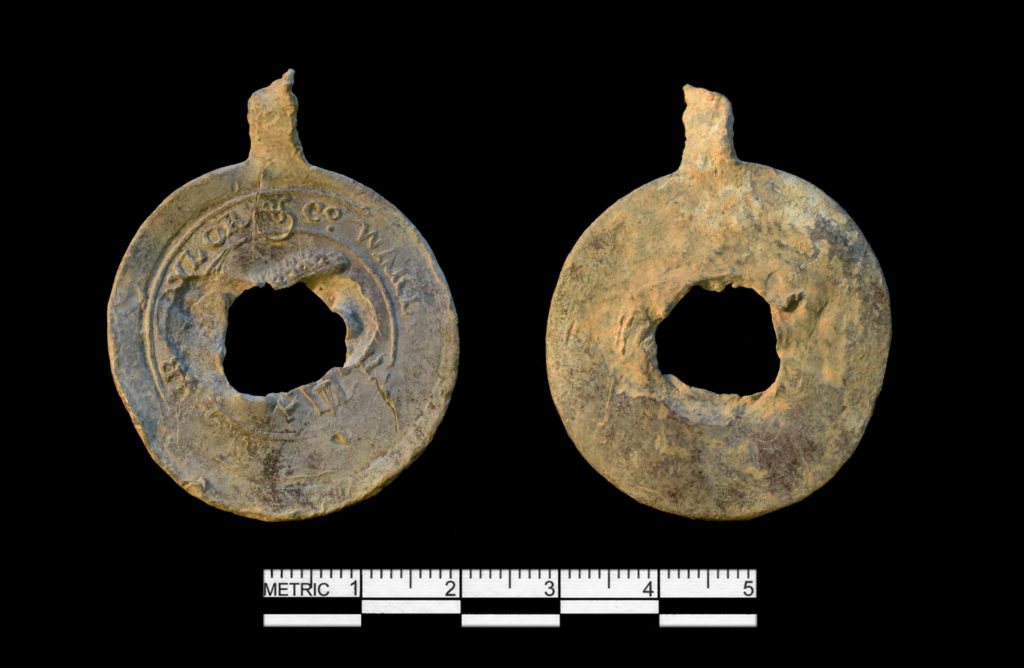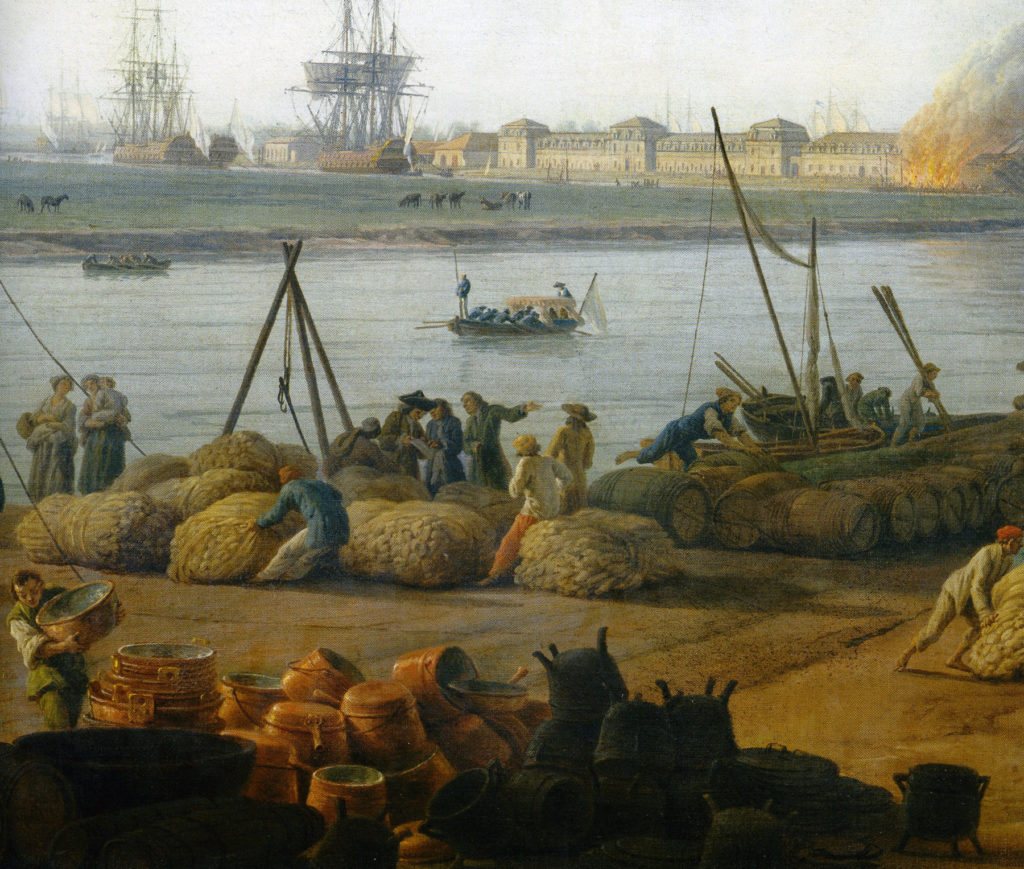Featured Fragment – A Lead Cloth Seal from John Lee Pratt Park
By Dr. D. Brad Hatch
In August 2016, Dovetail conducted archaeological excavations at John Lee Pratt Park on behalf of Stafford County. During these investigations, archaeologists uncovered and excavated a late-eighteenth-century trash pit likely associated with enslaved laborers on the Chatham plantation property. Although no longer officially associated with Chatham, the land on which John Lee Pratt Park is now located was once owned by William Fitzhugh of Chatham and likely served as an agricultural field and home to enslaved plantation laborers. Hundreds of artifacts were recovered from this trash pit that provide important information on the lives of the enslaved people during the early Fitzhugh ownership of Chatham. Among these artifacts was a lead cloth, or bale, seal (Figure 1).
These lead seals were attached to bolts of cloth starting in the Middle Ages, and perhaps as early as the Roman period, to indicate the quality of textiles (Endrei and Egan 1982:47; Noël Hume 1991:269–271). Generally, archaeologists in the new world have identified two types of lead cloth seals. One type of seal that consisted of four sections attached by lead strips was often used to indicate the payment of excise duties (Noël Hume 1991:269). The other, more common, type of lead seal consisted of a round loop and lug attached by a small lead strip. When used, the lugs on the seals were clamped over the loops using a tool that could impress marks into the lead. These two-part seals could have been used to indicate the payment of excise duties, but also often carried the marks of the cloth merchants.
The cloth seal recovered from the trash pit at John Lee Pratt Park is of the two-part variety, bearing the mark of cloth merchants from England. Although worn and fragmented, this cloth seal was complete enough to decipher the phrase “John and Jeremiah Naylor & Co. Wakefield,” along the loop portion. Additionally, the lug of the seal was marked with a sailing ship. John and Jeremiah Naylor were cloth merchants from Wakefield in West Yorkshire, England (Figure 2). This part of England was a major cloth producing area in the eighteenth century, and the Naylors were in operation from 1775 to 1829 (Daniels 1980:106–109). Other artifacts recovered from the trash pit suggest that this cloth seal likely dates from the first 25 years of the Naylor’s textile business.
The presence of this artifact in a trash pit associated with enslaved plantation laborers at Chatham helps to reveal the degree of access to consumer goods available to enslaved people in eighteenth-century Stafford County and the choices they made in selecting those goods. While goods, such as cloth, could have been handed down or pilfered from the manor house, it is much more likely that they were purchased by the enslaved people living at this site, perhaps from stores in nearby Fredericksburg or Falmouth. One of these stores could have been the one owned by William Allason in Falmouth, whose store ledgers indicate that he sold goods to enslaved members of the community (Martin 2008:191; Thompson 1931). Allason’s store was in operation from 1760 until the 1770s and could have been the source of the cloth represented by the lead seal.

Figure 3: 1853 Sketch by Lewis Miller of a Slave Dance in Lynchburg, Virginia. The blue cloth shawl and other adornment items worn by the women in this image were likely purchased from a local store.
Enslaved consumption from local stores during the late-eighteenth century was not uncommon in Virginia and much research has been conducted on enslaved consumption patterns and preferences from both archaeological and historical perspectives (Breen 2013; Heath 2004; Galle 2006; Martin 2008:173–193). Some of the most popular items purchased by enslaved people included alcohol, sweeteners, textiles, and various household goods (Heath 2004) (Figure 3). Other artifacts from the trash pit, including a wine glass stem and a fashionable creamware plate (see November 2016 post), indicate that the enslaved people at Chatham had access to these types of fashionable goods and actively sought them out. The consumer engagement among the enslaved at Chatham provided them with a more active role in shaping their material lives and identities, in addition to broadening their social networks, despite their segregation and isolation on farm quarters. These often unassuming objects excavated from enslaved contexts, like the cloth seal at John Lee Pratt Park, are able to tell the stories of everyday resistance and persistence despite the horrors and oppression of slavery.
Any distributions of blog content, including text or images, should reference this blog in full citation. Data contained herein is the property of Dovetail Cultural Resource Group and its affiliates.
References:
Breen, Eleanor E.
2013 The Revolution before the Revolution?: A Material Culture Approach to Consumerism at George Washington’s Mount Vernon, VA. Ph.D. Dissertation, Department of Anthropology. The University of Tennessee, Knoxville.
Daniels, Stephen John
1980 Moral Order and the Industrial Environment in the Woolen Textile Districts of West Yorkshire, 1780–1800. PhD Dissertation. University College of London, London, England.
Endrei, Walter, and Geoff Egan
1982 The Sealing of Cloth in Europe, with Special Reference to the English Evidence. Textile History 13(1):47–75.
Galle, Jillian E.
2006 Strategic Consumption: Archaeological Evidence for Costly Signaling among Enslaved Men and Women in the Eighteenth-Century Chesapeake. Ph.D. Dissertation, Department of Anthropology. University of Virginia, Charlottesville.
Heath, Barbara J.
2004 Engendering Choice: Slavery and Consumerism in Central Virginia. In Engendering African American Archaeology: A Southern Perspective, edited by Jillian E. Galle and Amy L. Young, pp. 19–38. University of Tennessee Press, Knoxville.
Martin, Ann Smart
2008 Buying into the World of Goods: Early Consumers in Backcountry Virginia. The Johns Hopkins University Press, Baltimore, Maryland.
Noël Hume, Ivor
1991 A Guide to Artifacts of Colonial America. Reprinted from 1969. Vintage Books, New York.
Thompson, Edith E. B.
1931 A Scottish Merchant in Falmouth in the Eighteenth Century. Virginia Magazine of History and Biography 39(2):108–117.


